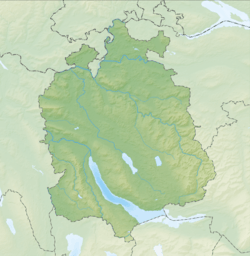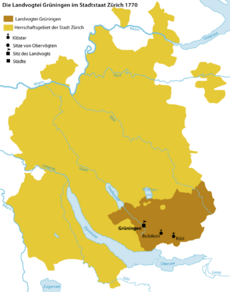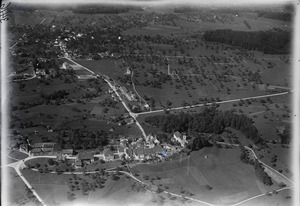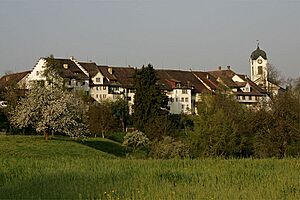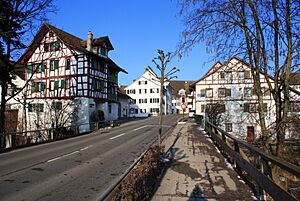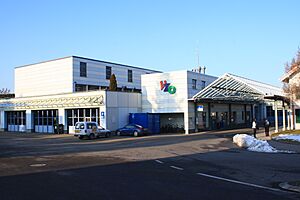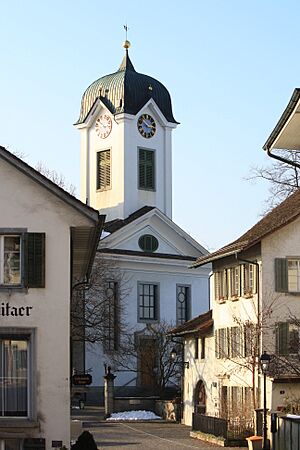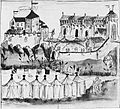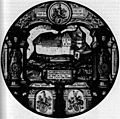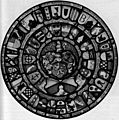Grüningen facts for kids
Quick facts for kids
Grüningen
|
||
|---|---|---|
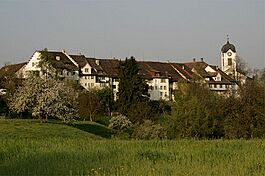 |
||
|
||
| Country | Switzerland | |
| Canton | Zürich | |
| District | Hinwil | |
| Area | ||
| • Total | 8.78 km2 (3.39 sq mi) | |
| Elevation | 502 m (1,647 ft) | |
| Population
(Dec 2020 )
|
||
| • Total | 3,716 | |
| • Density | 423.23/km2 (1,096.2/sq mi) | |
| Postal code |
8627
|
|
| Surrounded by | Gossau, Bubikon, Hombrechtikon, Oetwil am See, Egg | |
Grüningen is a charming town and municipality in the canton of Zürich in Switzerland. It's part of the Hinwil district. The town is famous for its old, well-kept historic center.
Contents
History of Grüningen
Grüningen was first mentioned in old records in 1243. Two nearby villages, Itzikon and Binzikon, are even older. Itzikon was first noted in 837, and Binzikon in 854.
Ancient burial mounds from the Hallstatt culture have been found in the Strangenholz area. These show people lived here a very long time ago. Later, around the 8th century, the Alamanni people settled here.
Grüningen Castle and City Rights
Grüningen castle was built in the early 1200s. It was likely built by the counts of Rapperswil. They managed the area for Einsiedeln Abbey. The abbey owned Grüningen between 1217 and 1222.
Around 1230, Grüningen became part of the Abbey of Saint Gall. It was first given to the counts of Kyburg. Then, in 1253, it went to Lütold VI of the Regensberg family.
A small settlement grew around the castle. In the mid-1200s, it became a medieval city. It gained walls and the right to hold markets. Lütold VI likely helped this development.
In 1269, Lütold had to give Grüningen back to St. Gallen. He was having money problems after fighting with Zürich and Rudolf von Habsburg. The abbey then pawned the area to Walter von Elgg in 1273. But King Rudolf I of Germany bought it the next year.
Grüningen had city rights before 1370. This is known from its city seal and coat of arms. It was one of only four places in Zürich with city rights before the end of the Middle Ages. The others were Zürich, Winterthur, and Elgg.
Under Habsburg Rule
The town stayed under Habsburg control through the 1300s. The counts of Toggenburg managed it from 1314. Later, Heinrich Gessler of Meienberg took over in 1374.
Gessler made the castle stronger to protect it from the Old Swiss Confederacy. Zürich attacked Grüningen several times in the 1370s and 1380s.
Heinrich Gessler died in 1403. His son Hermann had to give Grüningen to Zürich. Heinrich Hagnauer became the new manager in 1416. He was very strict, which made the people unhappy.
Frederick IV, Duke of Austria tried to get Grüningen back from Zürich. But he was never successful.
Old Zürich War
In 1440, forces from Schwyz and Glarus attacked Grüningen. This happened during the Old Zürich War. About 1,000 soldiers surrounded the town and castle. Jakob Murer and 40 men defended it.
They surrendered on November 10, 1440. Zürich then had to sign a bad peace treaty. Frederick III, Holy Roman Emperor wanted Grüningen back for Habsburg. But Bern helped keep it with Zürich.
In 1443, fighting started again. Grüningen was attacked from July 11 to 16. The defenders surrendered again. The attackers killed Zürich's manager, Peter Kilchmann, even though they promised safety.
The rest of the soldiers went back to Zürich. There, they were put in prison and fined for being cowards. With Grüningen in Swiss hands, the area was raided by Swiss troops. They attacked Greifensee in May 1444. The entire group defending Greifensee was killed after surrendering.
In 1450, a peace treaty returned Grüningen to Zürich. It remained a district managed by Zürich until 1798. That's when the French invaded Switzerland.
Conrad Grebel (around 1498–1526) was likely from Grüningen. He helped start the Swiss Brethren movement.
Modern Times
In 1815, the old district of Grüningen became the district (Oberamt) of Grüningen. The town didn't grow much in the 1800s. It didn't join the industrial revolution very much.
By 1836, 300 people worked in farming. Another 200 worked from home making cotton and silk. In 1831, the main office of the district moved to Hinwil.
The population dropped from about 1,700 in 1850 to 1,200 in 1900. Mail coaches connected Grüningen to Zürich from 1836. Another line went to Stäfa from 1838.
Grüningen was on the Wetzikon–Meilen tramway line from 1903 to 1950. Since 1950, buses have served the town. The population slowly grew back to 1,700 by 1960. After 1960, it grew faster, reaching over 3,000 by 2010.
In 1976, Grüningen won the Wakker Prize. This award is for keeping its old buildings and history well-preserved.
A new road, called a bypass, has been planned since 2003. It will help protect the historic town center from too much traffic. A design by Santiago Calatrava was chosen in 2018.
Geography of Grüningen
The municipality of Grüningen covers about 8.8 square kilometers (3.4 square miles). Most of this land, 62.5%, is used for farming. Forests cover 20.5% of the area.
About 14.6% of the land has buildings or roads. The rest, 2.5%, is non-productive, like rivers or mountains. In 1996, buildings and homes made up 10.6% of the total area. Roads and other transport areas made up 4%.
The municipality is in the Zürcher Oberland region. It includes the main town of Grüningen. It also has smaller villages and hamlets like Itzikon, Binzikon, Bächelsrüti, Adeltshausen, and Holzhausen. There are also scattered individual houses.
Wakker Prize
Grüningen received the Wakker Prize for its efforts to protect its history. The Heimatschutzgesellschaft (Swiss heritage society) worked hard on this. They made sure any changes to the town kept its historic look.
They also suggested ways to improve the town. This society created and ran a local museum. They also held cultural events and shared information about the town's history.
People of Grüningen (Demographics)
Grüningen has a population of 3,716. About 11.1% of the people are from other countries. In 2008, the population was almost evenly split between males (49.6%) and females (50.4%).
Over the last 10 years, the population has grown by 4.4%. Most people (92.0%) speak German. Italian is the second most common language (1.9%), followed by English (1.3%).
In the 2007 election, the SVP was the most popular. They received 43.5% of the votes.
Young people (0–19 years old) make up 24.4% of the population. Adults (20–64 years old) are 61.8%. Seniors (over 64 years old) are 13.8%. Many people in Grüningen are well-educated. About 75.2% of adults (25-64) have finished high school or gone to college. There are 1135 households in Grüningen.
Grüningen has a low unemployment rate of 1.36%. In 2005, 136 people worked in farming. There were 49 businesses in this area. 300 people worked in manufacturing, with 36 businesses. 803 people worked in services, with 88 businesses. In 2007, 46% of workers had full-time jobs, and 54% worked part-time.
In 2008, there were 663 Catholics and 1573 Protestants in Grüningen. The 2000 census showed that 57.7% were Protestant. This included 53.3% from the Swiss Reformed Church. 25.7% of the people were Catholic. About 10.2% said they had no religion.
The table below shows how the population has changed over time:
| year | population |
|---|---|
| 1467 | 38 Households |
| 1634 | 674 |
| 1739 | 1,040 |
| 1850 | 1,695 |
| 1900 | 1,207 |
| 1950 | 1,450 |
| 1990 | 2,597 |
| 2000 | 2,811 |
| 2010 | 3,165 |
Climate
Grüningen gets rain on about 144.3 days each year. On average, it receives 1328 millimeters (52.3 inches) of rain. August is the wettest month, with about 162 millimeters (6.4 inches) of rain. During August, it rains for an average of 14.3 days.
Notable People
- Conrad Grebel (around 1498–1526) was a co-founder of the Swiss Brethren movement. He was probably born in Grüningen.
Images for kids
See also
 In Spanish: Grüningen para niños
In Spanish: Grüningen para niños




